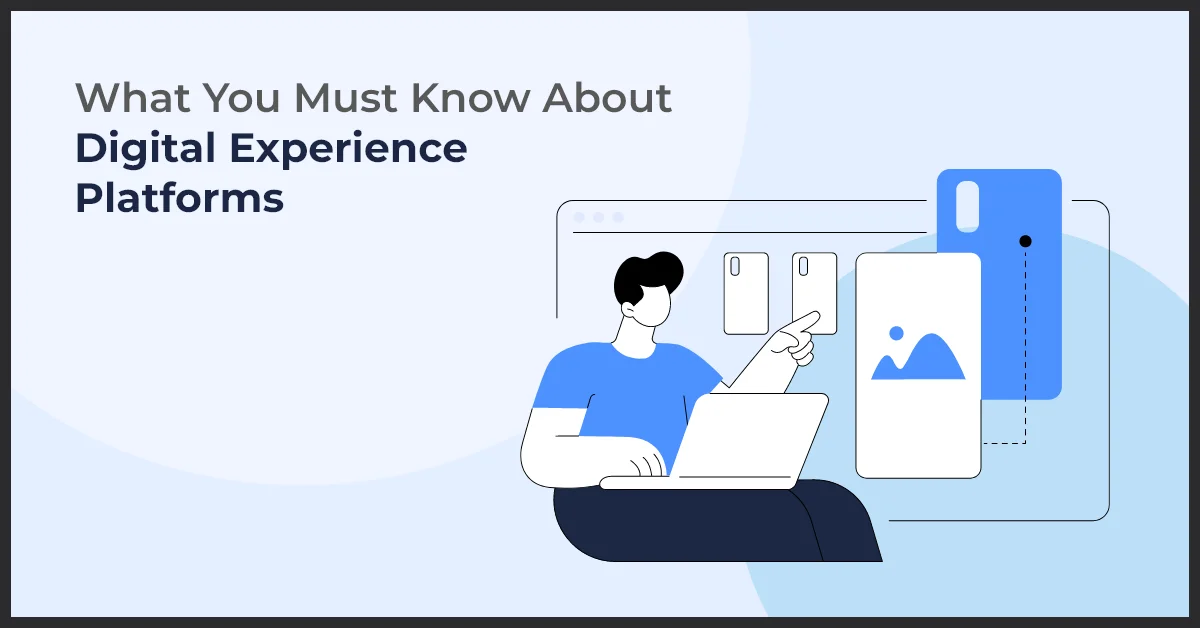What You Must Know About Digital Experience Platforms

Published on: February 22, 2022
Updated on: June 26, 2024
2315 Views
- Digital Marketing
15 min read
Experience is the holy grail that determines a customer’s engagement with a brand. All brands are focused on improving the experience for their customers at every stage of the business from marketing to sales and finally, customer support.
The Covid-19 pandemic forced brands to rework their digital strategy and it is well summarized in this report by McKinsey. Digital is no longer one of the tough points but THE TOUCH POINT for businesses. Brands are increasingly investing in building digital experience platforms (DXPs) and the DXP market is expected to become $13.9 billion by the year 2024.
What Are Digital Experience Platforms?
DXPs are defined as an integrated set of technologies that are aimed at creating, maintaining, and optimizing the digital experience for customers. The idea behind DXPs is to provide customers with an engaging and integrated experience across different channels.
Brands connect customers to their employees, partners, suppliers, and other stakeholders in the business cycle to improve satisfaction and garner loyalty. Building DXPs starts with defining experience and building the technologies and capabilities that help you meet the expectations of your customers.
Key Components of a Digital Experience Platform
A digital experience platform (DXP) combines various tools and technologies to provide a seamless and engaging experience for users. These key components work together to deliver personalized and interactive experiences.
User interface (UI) design
UI design plays a crucial role in a DXP as it focuses on creating visually appealing and intuitive interfaces. A well-designed UI enhances user engagement and satisfaction by ensuring a smooth and enjoyable browsing experience.
Customer experience (CX) management
DXPs prioritize CX management to understand and meet the unique needs and expectations of customers. Analyzing customer behavior and preferences helps in tailoring experiences across different touchpoints and improving overall satisfaction.
Content management systems (CMS)
A robust CMS allows businesses to efficiently create, manage, and deliver content across multiple channels. It enables easy content customization and personalization, ensuring that users receive relevant and engaging content.
Customer relationship management (CRM)
Integration with CRM systems enables DXPs to leverage customer data and insights. This helps businesses build strong customer relationships, deliver targeted marketing campaigns, and provide personalized experiences based on individual preferences.
Data analytics and insights
DXPs rely on advanced analytics tools to collect and analyze data from various sources. These insights enable businesses to understand user behavior, measure the effectiveness of campaigns, and make data-driven decisions to improve the overall digital experience.
Enhancing Customer Experiences
When it comes to the success of your business, customer experience is paramount. A digital experience platform can help you take your customer interactions to new heights. Let's explore some key features that can enhance customer experiences:
Personalization and targeting
With a digital experience platform, you can deliver personalized content and experiences to each customer. By understanding their preferences, demographics, and behavior, you can create tailored experiences that resonate with them, ultimately driving engagement and loyalty.
Multi-channel marketing
A digital experience platform allows you to reach customers across multiple channels, ensuring consistent experiences and messages. From email marketing to social media campaigns, you can provide a seamless journey wherever your customers are.
E-commerce capabilities
Integrate your digital experience platform with e-commerce functionalities to create a frictionless online shopping experience. From product recommendations to easy checkout processes, you can streamline the entire customer journey, boosting conversions and sales.
Mobile app development
With the increasing use of smartphones, having a mobile app is crucial. A digital experience platform enables you to develop and optimize mobile apps to provide a user-friendly experience on the go. Mobile apps can enhance customer engagement, convenience, and loyalty.
Social media integration
Leverage the power of social media by integrating it with your digital experience platform. From social sharing to social login options, you can make it easy for customers to engage with your brand on social media platforms, expanding your reach and fostering a sense of community.
Artificial intelligence (AI) and machine learning (ML) applications
Utilize AI and ML technologies within your digital experience platform to gain insights and automate processes. By analyzing customer data, you can deliver personalized recommendations, automate customer service, and optimize user experiences, ultimately enhancing customer satisfaction and driving business growth.
By incorporating these features into your digital experience platform, you can elevate customer experiences to new heights, differentiate your brand, and drive business success.
Why Are Digital Experience Platforms (DXPs) Becoming More Popular?
Digital experience platforms help in creating coherent customer experiences and earning their loyalty. Brands across industries deploy them for several reasons such as:
1. Maintain cohesive information channels…
Brands target their customers across different channels. When these individual channels work in silos, they tend to create information gaps. DXPs let different teams in your organization collaborate while also engaging with your customers. This breaks the traditional silos of communication and creates cohesive information channels.
2. Customer aspirations have changed…
Technology, particularly the internet has been shaping our lives and this has led to changing customer aspirations. Customers look for more than your products and contact details when they are on your website or social media handles. DXPs help meet these aspirations at every stage of the customer’s journey.
3. Faster and more interactive engagement…
Mobile devices and social media are ensuring faster engagement between brands and their customers. DXPs leverage the true power of immediacy and create new opportunities for brands to interact with their customers. This engagement helps improve customer satisfaction and build brand reputation.
4. Promotes streamlining and automation…
Brands use forms to generate leads and conduct surveys. Manual form processing is a tedious exercise and is best avoided. DXPs help in streaming the process with form automation. Right from the stage of form creation to authentication and validation, they automate the workflow improving business productivity.
5. Remote-work ready…
The Covid-19 pandemic has changed the way people work and remote working is rapidly becoming a norm for the future. Cloud-based DXPs offer brands the ideal platform that can be managed by remote teams. They can collaborate seamlessly with access control features and remove live monitoring.
Advantages of a DXP
As we have already stated, digital experience platforms help brands deliver a more personalized experience to their customers. In addition, they let your brand meet the expectations of your customers in a technology-driven world. Let us look at some of the distinct advantages of having a DXP over traditional digital platforms:
1. Delivery Across Touchpoints
Customers engage with your brand across different touchpoints—web, mobile, kiosks, voice assistants, chatbots, and your support team. As these touchpoints continue to grow, DXPs create the synergy between multiple touchpoints and deliver consistent experiences.
2. Flexible Architecture
Unlike other web technologies that require the back-end and front-end teams to work in tandem, DXPs let them work independently. This ensures faster deployment of services across touchpoints, quicker redressal of complaints, and comprehensive building of your technology stack.
3. Secure Information
DXPs enable brands to operate highly secure websites. Unlike open-source platforms, digital experience platforms are built on robust security principles. Vulnerabilities across platforms and technologies can be monitored and tested centrally in these platforms. This makes them ideal for businesses that depend on the security of their data and need to offer secure access to their content.
4. Business Integration
Success for any brand is dependent on the integration of their marketing, sales, and customer support team. When there is synergy between these teams, businesses prosper, and any loose ends would result in poor ratings and dissatisfaction. Digital Experience Platforms integrate different business processes and help your brand stand ahead of the competition.
5. AI-Driven Reporting
The more your brand knows about its customers, the more likely you are to deliver increased customer satisfaction and drive more sales. DXPs are AI-driven and they provide decision-makers in your organization with actionable insights on your customer by analyzing data from different touchpoints. On the customers’ side, they help them find the relevant information that they are looking for and prevent getting lost under tons of content.
5 Ways How DXPs Address Today's Customer
So far, we have seen the importance of digital experience platforms and the reasons behind their popularity. However, the real reason behind their popularity is how they address the needs of customers. Let us look at five ways how DXPs address today’s customers:
1. Customer-Friendly Content
Content remains the ‘King’ in digital experience platforms, taking content marketing to the next level. Connect all your internal operating systems to deliver customer-friendly content. Irrespective of the touchpoint the customer uses to engage with your brand, you can offer the information they are looking for.
2. Uniformity of Content
Imagine a scenario where your FB page announces a $20 discount on your latest designer wear but your Instagram handle carries the old price. With DXPs, you can avoid such anomalies as it ensures uniformity of content across channels.
3. Customer Insights
We have already discussed how DXPs offer customer insights. It is not just important for brands but also for customers. Thus, it ensures that you are reading and hearing customers’ changing aspirations and also working upon their expectations.
4. Personalized Solutions
Today’s customers like being pampered. They want brands to offer them tailored products and services that address their pain points. DXPs ensure that; thanks to better insights on the customer. Regardless of the channel the customer uses to engage with your brand, you can capture their desires. Therefore, you can deliver personalized solutions.
5. Fast Time to Market
Time-to-market is one of the most important elements driving success for brands as well as customers. In the fast-changing world of technology and products, customers want to move on to the latest products and technologies and not fall behind in the race.
Managing Omnichannel Communication
Omnichannel communication is a holistic approach that allows businesses to engage with customers across multiple channels seamlessly. It ensures a consistent experience for customers, regardless of the channel they choose to interact with a brand.
One of the key benefits of omnichannel communication is the ability to provide a cohesive and integrated experience for customers. By connecting various communication channels such as websites, social media platforms, mobile apps, and physical stores, businesses can deliver a unified message and brand experience.
Seamless communication across channels is crucial for businesses in today's digital landscape. Customers expect to be able to engage with a brand through their preferred channel, and they expect consistent messaging and experiences. Omnichannel communication allows businesses to meet these expectations, resulting in higher customer satisfaction and loyalty.
Integrating with third-party systems and tools is another essential aspect of managing omnichannel communication. By integrating with customer relationship management (CRM) systems, marketing automation platforms, and other tools, businesses can centralize customer data, track interactions across channels, and deliver personalized experiences.
These integrations enable businesses to gather valuable insights about their customers' preferences, purchase history, and behavior, allowing them to create targeted and relevant communication strategies. By leveraging existing data and tools, businesses can optimize their omnichannel communication efforts and create stronger relationships with their customers.
Optimizing Digital Experiences
When it comes to digital experiences, it's crucial to continuously improve and enhance your offerings. By optimizing your digital experiences, you can provide a seamless and engaging journey for your customers. Here are some strategies and tools that can help you in this process:
A/B testing and optimization strategies
One of the most effective ways to optimize your digital experiences is through A/B testing. By creating multiple versions of your webpage or content and testing them with different audiences, you can gather valuable data on what resonates best with your target audience. This allows you to make data-driven decisions and continuously improve your digital experiences.
Web and mobile analytics
Web and mobile analytics play a crucial role in optimizing digital experiences. By monitoring user behavior, traffic patterns, and conversion rates, you can gain insights into how users interact with your website or mobile app. These insights can help you identify areas for improvement, such as optimizing page load times, improving user flows, or addressing usability issues.
Utilizing data analytics for continuous improvement
Data analytics is a powerful tool for optimizing digital experiences. By analyzing data from various sources, such as customer interactions, social media engagement, or sales data, you can uncover patterns, trends, and opportunities for improvement. This data-driven approach allows you to identify key areas where you can enhance your digital experiences and better meet customer needs.
Optimizing your digital experiences is an ongoing process that requires continuous monitoring and improvement. By leveraging A/B testing, web and mobile analytics, and data analytics, you can stay ahead of the competition and deliver exceptional digital experiences to your customers.
The Role of a Digital Experience Platform in Business Success
A digital experience platform (DXP) plays a crucial role in driving business success in today's digital landscape. Leveraging a DXP can help businesses deliver exceptional experiences to their customers, resulting in increased customer satisfaction and loyalty.
A DXP allows businesses to optimize their customer journey and conversion rates by providing personalized and seamless experiences across various digital touchpoints. Through the use of data and analytics, businesses can better understand their customers' preferences and behaviors, allowing them to tailor their offerings and communication accordingly.
Furthermore, a DXP enhances customer service and support by enabling businesses to provide timely and relevant assistance. With features like live chat, self-service portals, and interactive FAQs, businesses can ensure that their customers have easy access to the support they need, resulting in improved customer satisfaction.
Impact on Customer Satisfaction and Loyalty
By using a DXP, businesses can create consistent and impactful experiences that resonate with their customers. This not only increases customer satisfaction but also fosters long-term loyalty. When customers feel understood and valued, they are more likely to continue doing business with a company and even advocate for their brand.
Improving Customer Journey and Conversion Rates
One of the key benefits of a DXP is its ability to improve the customer journey and drive conversion rates. By mapping out the customer journey and identifying pain points or areas of improvement, businesses can leverage their DXP to optimize each stage of the journey. From initial awareness to the final conversion, a DXP enables businesses to deliver personalized and targeted experiences that guide customers towards a desired action.
Enhancing Customer Service and Support
A DXP equips businesses with the tools they need to provide exceptional customer service and support. By integrating customer service features directly into their digital platforms, businesses can streamline the support process and ensure that customers have access to assistance whenever they need it. This not only improves customer satisfaction but also reduces the burden on customer support teams.
Integration with Customer Relationship Management (CRM)
Customer Relationship Management (CRM) is a crucial tool for businesses to manage and nurture their relationships with customers. When integrated with a Digital Experience Platform (DXP), CRM data can be leveraged to enhance customer understanding and targeting, as well as streamline sales and marketing efforts.
- Leveraging CRM data within a digital experience platform: By integrating CRM data with a DXP, businesses can gain valuable insights about their customers' preferences, behaviors, and purchase history. This data can then be used to personalize and tailor the digital experiences delivered through the DXP, creating more engaging and relevant interactions.
- Enhancing customer understanding and targeting: With CRM integration, businesses can create a unified view of each customer, combining data from various touchpoints and channels. This holistic view allows for a deeper understanding of customer needs and preferences, enabling more targeted and personalized marketing campaigns.
- Streamlining sales and marketing efforts: By integrating CRM with a DXP, businesses can automate processes and workflows, reducing manual efforts and eliminating data silos. This integration ensures a seamless flow of customer data between the CRM and DXP, enabling more efficient sales and marketing activities.
Conclusion
Customers are aspirational, and they are always looking for better experiences from brands. If you are looking to deliver the best digital experience to your customers, it is time to embrace DXPs.
In today’s world, DXPs are becoming the centerpiece for customer experience and earning the loyalty of customers. By investing in a digital experience platform, your brand shall bridge the gap between customer experience and other elements of your business process. From service to sales and marketing to commerce tools, DXPs ensure happier customers and stronger brand loyalty.
A successful business thrives on customer satisfaction, and a digital experience platform empowers organizations to meet and exceed customer expectations. By implementing a DXP, businesses can create meaningful and memorable experiences for their customers, thereby building brand loyalty and driving revenue growth. It offers businesses the tools and capabilities they need to stay competitive in the modern digital landscape.
If you wish to leverage digital experience platforms and get your business ready for the future, Growth Natives can help. Let us analyze all your digital assets and review the application landscape thoroughly. We have an experienced team of digital marketers who can take your business to the next level. To discuss the details of your project, write to us at info@growthnatives.com or visit our website.
Frequently Asked Questions
Digital Experience Platforms (DXPs) are software solutions that provide businesses with the tools and capabilities to manage and deliver personalized digital experiences to their customers across various channels, such as websites, mobile apps, and social media. DXPs typically include features for content management, digital marketing, analytics, and personalization.
DXPs are designed to help businesses create and manage seamless digital experiences for their customers. They integrate various technologies and tools to provide a unified platform for managing content, engaging with customers, and analyzing data to optimize the digital experience.
Digital experience encompasses all interactions that users have with a brand or organization through digital channels. This includes interactions with websites, mobile apps, social media platforms, email campaigns, and other digital touchpoints. A positive digital experience is essential for attracting and retaining customers.
The components of a digital platform customer experience include:
- Content management: Tools for creating, managing, and delivering content across digital channels.
- Commerce capabilities: Features for enabling online transactions and e-commerce functionality.
- Personalization: Tools for tailoring content and experiences based on customer preferences and behavior.
- Analytics: Tools for tracking and analyzing customer interactions to gain insights and improve the digital experience.
- Integration capabilities: Ability to integrate with other systems and platforms to provide a seamless experience across channels.
- Mobile optimization: Ensuring that the digital experience is optimized for mobile devices.
- Social media integration: Integrating with social media platforms to enable sharing and engagement.
- Customer service and support: Providing tools for customer service and support through digital channels.



